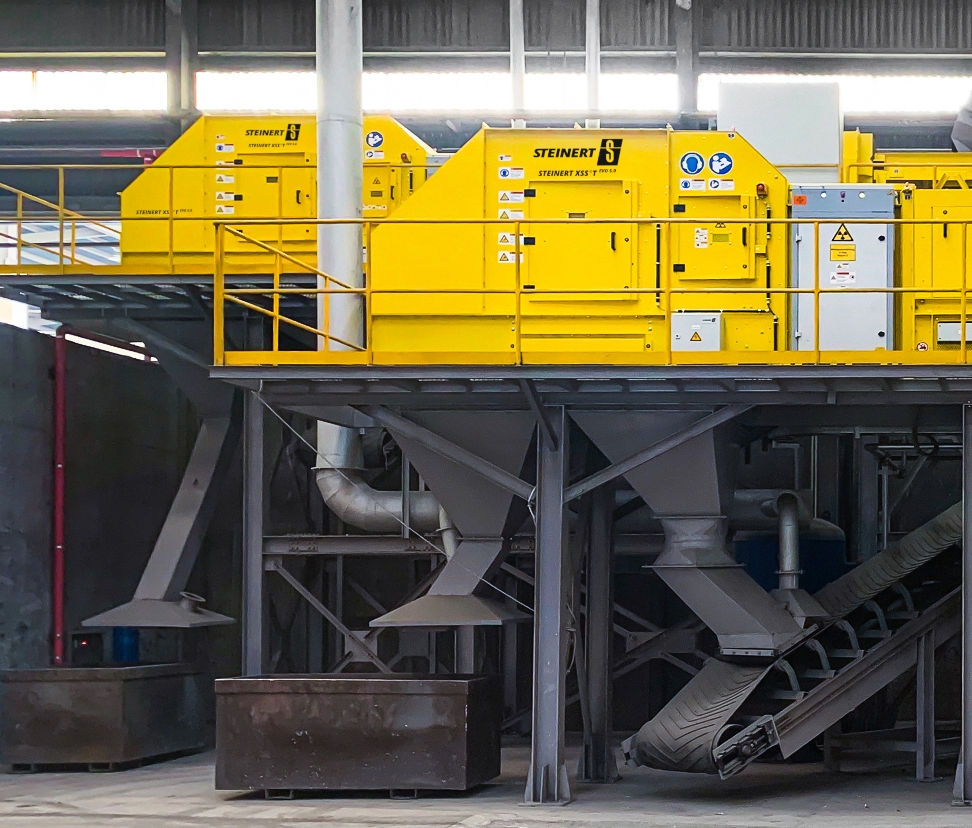















































Today’s automotives are built from around 40 different materials including a complex mix of alloys and polymers. Processing end-of-life motor vehicles involves dealing with thousands of parts and requires cutting-edge technology. After a vehicle has been shredded, air separation occurs before steel and iron are separated, resulting in shredder light fraction. Following this process, non-ferrous metal separators with magnetic pole systems separate the high-grade non-Fe metal fraction (ZORBA). Once the non-ferrous metals have been separated, the automotive shredder residue (ASR) uses highly efficient sorting technology to recover valuable aluminium product for resale. High-performance, dual-energy X-ray sorters are the key to processing ZORBA. The atomic density of every particle is measured, using high-precision, ultrafast data processing. This results in a clean, high-value aluminium output, removing any plastic products and wood contaminants.
















































X-ray fluorescence technology enables recyclers to identify and distinguish materials, such as copper from zinc or brass. Known as an X-ray fluorescence analyser (XRF), this type of equipment can be used on heavily soiled materials from incinerated waste. This advanced technology can also be used on scrap metal with metallic coatings. Using element-based material analysis, highly valuable copper, zinc and nickel can be separated. Despite only the surface being evaluated, X-ray fluorescence can identify the elemental composition of materials. This offers opportunities to gain accurate knowledge about these materials.
3D detection sensor systems use laser triangulation to precisely detect objects, allowing cutting-edge material mapping. This technology improves extraction and reduces compressed air consumption. X-ray sorting systems can usually be used on working widths from 1,000mm to 2,000mm and a grain size range of 10mm to 120mm.
















































Millions of tonnes of ash are produced each year from municipal solid waste. Within waste incinerators, bottom ash can contain high levels of mineral traces, ferrous and non-ferrous metals. Mineral content can often be reused within the construction sector, and separated metal can be marketed to the metallurgy industry. Non-ferrous metals such as aluminium and copper have an average value of around €500 per ton.
Ash can present processing challenges, especially high-moisture levels. Robust and precise separation technology needs to operate efficiently with low maintenance and ease of use. Magnet drums need to be resistant to wear. Permanent suspension magnets with stainless steel housing prevents interference by secondary magnets. Multi-pole magnet systems can capture and discharge metal parts, and a transverse pole can process difficult materials.
















































Waste electrical and electronic equipment (WEEE) has increased in recent years due to the use of electronic and electrical components in smart devices. Modern technology typically contains ferrous and non-ferrous metals, including aluminium, copper, plastics, and precious metals, such as gold and silver. Known as “e-scrap” there has also been an increase in conserving rare-earth metals. If you want to achieve cleanly sorted products and a high market value for your recycled materials, you need purity.
Advanced sorting technology and multi-sensor sorting systems with multiple programmable levels can produce high-purity copper, aluminium, brass, and more. High-resolution camera technology can be used to sort e-scrap plastics. Plastics such as ABS, PS, PP and PC can be sorted from black plastics using BlackEye technology. Cables can be processed using combination sensor sorting equipment and colour sorting units.
















































Foundry residues contain large quantities of slag, which are produced as a by-product of metallurgical smelting processes and waste. In solid form, large, coated metal particles and metal chunks can be found. The recovery and reconditioning of this metal content can be profitable. Bonded chemicals used in the metallurgical process can also be retrieved and re-used, along with the salts used to formulate slag. Coated metal parts such as aluminium can also be recovered through dry processes, following crushing and grain classification.
Aluminium separation can be achieved efficiently using eddy current separators. Due to separating splitter mechanisms, fine grain sizes up to 0.5 mm can be processed. A high-frequency pole drum can achieve high purity levels and yields. Ferromagnetic slag components can be separated using electromagnetic or permanent magnetic drums.


Looking for a technical solution, parts or training for your recycling operations?
We share updates on projects, equipment, and key developments that are influencing the metal and wood recycling sector.